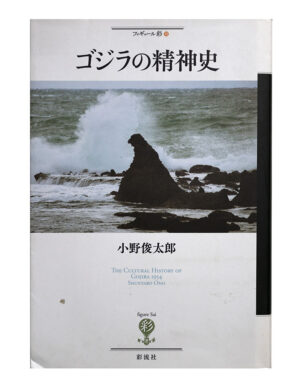7.24.2023
The Cultural History of Godzilla – Pt 57


P 151
風船爆弾が落ちたり、Uボートのような潜水艦が船舶を脅かしたくらいである。東京やベルリンのような空襲や広島や長崎の原爆のような焦土と化す被害を受けたわけではない。イギリスもドイツの本土上陸による侵攻は受けなかったが、「バトル・オブ・ブリテン」の空中戦があったり、V2による攻撃でロンドンが被害を受けたのとは、大きな違いがある。そもそも、アメリカ独立戦争以来、敵国に本土を蹂躙されていないことがアメリカの「例外主義」を補完し、神が守ってくれる土地だという証明とされる。南北戦争はあくまでも内乱という解釈であり、ヴェトナム戦争の敗走も他国での戦争の結果であり、それは現在も同じでアメリカ本土が戦場になっているわけではない。
Balloon bombs dropped and submarines like U-boats threatened ships. It did not suffer damage like the air raids on Tokyo and Berlin, or the atomic bombings on Hiroshima and Nagasaki. Britain also did not invade the German mainland, but there is a big difference from the air battle of “Battle of Britain” and London being damaged by the attack by V2. In the first place, the fact that the mainland has not been overrun by enemy countries since the American Revolutionary War complements America’s “exceptionalism” and is proof that it is a land protected by God. The Civil War was interpreted as a civil war, and the defeat of the Vietnam War was the result of wars fought in other countries.
だとすると、ゴジラが大戸島を襲い、ついで東京を襲うという構図は、ハワイを襲ったあとでアメリカ本土を攻撃する、という実現しなかったもうひとつの太平洋戦争を自虐的にかつ空想的に表現している。『ハワイ・マレー沖海戦』の延長上に、戦後東宝戦記物が解禁となる。そして、本多猪四郎が第一作の『太平洋の鷲』で山本五十六を描き、さらに「さらばラバウル」で航空隊を描き、その後『ゴジラ』を作った。現実の戦争を踏まえた戦記ものから「日米架空戦記物」となったと捉えることができる。『ゴジラ』という映画に対して日本人の観客が単純な怪物退治物だと割り切れない複雑な感情をもつのは、この映画のなかには「アメリカとしてのゴジラ」と「日本としてのゴジラ」の姿が二者択一ではなく、どこまでも並存しているせいなのだ。
If so, the composition of Godzilla attacking Odo Island and then Tokyo is a self-deprecating and fantastical expression of another Pacific War that did not come true, attacking Hawaii and then attacking the mainland United States. As an extension of “The Battle of Hawaii and Murray,” the ban on Toho war record was lifted after the war. Then Ishiro Honda drew Isoroku Yamamoto in his first film, “Operation Kamikaze,” then the Air Corps in “Farewell Rabaul,” and then “Godzilla.” It can be understood that it has changed from a war chronicle based on a real war to a “Japanese-American fictitious war chronicle.” The reason why Japanese audiences have mixed feelings about the movie “Godzilla,” which cannot be divided into simple monster extermination, is that in this movie, “Godzilla as America” and “Godzilla as Japan” coexist endlessly, rather than just choosing between the two.
『ゴジラ』を読み替えるアメリカ
America rereading “Godzilla”
では、アメリカ人にはゴジラはどう見えるのだろう。それを明らかにするのが、他ならない一九五六年に全米公開された『怪獣王ゴジラ』である。
So what does Godzilla look like to Americans? It is none other than Godzilla, the King of Monsters, released in the United States in 1956, that reveals this.

P 152
足音が響くのは同じだが、いきなり栄光丸の上で船員が見る海にゴジラの白光が光る場面が出てきて、そこにタイトルが重なる。一転して第二回ゴジラ攻撃後の焦土と化した東京の風景が出てくる。そして病院に運びこまれたスティーブ・マーテインという男の回想の形で映画が進んでいく。
The sound of footsteps is the same, but suddenly there is a scene where the white light of Godzilla shines in the sea seen by the sailors on the Eikomaru, and the title overlaps there. In contrast, the scorched earth of Tokyo after the second Godzilla attack appears. And the movie progresses in the form of the recollection of a man named Steve Martin who was brought to the hospital.
ここで視点的人物となるマーティンは、シカゴのワールド・ニュースという通信社の海外特派員である。カイロに行く途中に大学時代の友人である芹沢博士に会うために東京に立ち寄り、ゴジラ戦争と遭遇する。萩原という新聞記者が、マスコミ代表という立場で『ゴジラ』のなかでは大戸島の取材をしたり、芹沢博士の秘密を探るという重要な役目をもってずっと登場するのだが、それがマーティンを造形するヒントになったのだろう。
Martin, the point of view here, is a foreign correspondent for the Chicago-based news agency World News. He stops in Tokyo to meet his college friend Dr. Serizawa on his way to Cairo and encounters Godzilla’s attack. Hagiwara, a newspaper reporter, appears throughout Godzilla as a representative of the mass media, covering the island of Odo and exploring the secrets of Dr. Serizawa.
マーティンは芹沢博士の紹介で山根博士を知り、さらに娘の恵美子とも顔見知りだった。第二回のゴジラ攻撃で負傷した後で再会し、英語で近況を話したりする。マーティンは日本語を理解しないので、通訳ともいえる防衛隊のイワナガという人物が同行してくれ、人々の会話などの内容を紹介してもらう。マーティンによるナレーションとあいまって、日本語を理解しないアメリカの観客にもわかりやすく物語を伝えるように編集されている。
Martin came to know Dr. Yamane through Dr. Serizawa’s introduction, and was also acquainted with his daughter Emiko. He reunites with him after being injured in the second Godzilla attack and talks about his current situation in English. Since Martin doesn’t understand Japanese, a person named Iwanaga from the Defense Corps, who can be said to be an interpreter, accompanies him and asks him to introduce the contents of people’s conversations. Combined with the narration by Martin, it is edited to convey the story in an easy-to-understand manner for American audiences who do not understand Japanese.
『怪獣王ゴジラ』は人間関係や状況を要約するマーティンの語りでまとまりながらも、日本語だけの場面、英語の吹き替えの場面、マーティンとイワナガによる解説が入る場面と複雑に成り立っていある。日本の国会なのにいきなり山根博士が英語で説明を始めたり、吹き替えが別のセリフになっていたり、カットもオリジナルとは異なるところで使われているといった違いもある。マーティンの登場する場面はなんと一日で撮影されたとされるが、画面の切り返しや後姿の代役なども使いながら、なかなか巧みに合成されている。
“Godzilla, the King of Monsters” is composed of Martin’s narrative summarizing human relationships and situations, but it also has a complicated structure with scenes that are only in Japanese, scenes that are dubbed in English, and scenes that include commentary by Martin and Iwanaga. There are also differences such as Dr. Yamane suddenly starting to explain in English even though it is a Japanese parliament, dubbing has different lines, and cuts are used in places different from the original. The scene in which Martin appears is said to have been filmed in one day, but it is quite skillfully synthesized while using screen cuts and substitutes for the rear view.

P 153
もっともしゃべらないでいる間をもたせるために、彼がしょっちゅうパイプや紙タバコを口にくわえているのが印象的だが。あとから編集して場面を挿入してこのように物語を操作できるのも、映画という媒体のおかげである。
Most impressive is that he often has a pipe or cigarette in his mouth to keep him quiet. It is also thanks to the medium of film that we can manipulate the story in this way by editing and inserting scenes later.
話の流れは基本的にはオリジナルに沿っている。海上保安庁や国会で取材をしたあと、マーティンは報道陣としてヘリコプターに同乗して大戸島に向かう。イワナガといっしょにテントを張って一泊しているときに、嵐のなかでのゴジラ攻撃に遭遇する。また、国会での会議でも、第一回のゴジラの品川攻撃も立ち会っている。特に第二回攻撃では、ずっと実況中継のようにシカゴの上司に送る記事のためにマイクを握って録音しているのだが、ゴジラにビルを倒されて負傷する。それで冒頭の回想シーンの始まりにつながる。その後は、恵美子が芹沢博士が秘密兵器をもっているという話をすると、「明日は横浜や大阪が襲われる」といって、尾形といっしょに説得にいくように促す。そして、巡視船しきねの上では、記者であることを忘れたかのようにゴジラ死滅までのいきさつを見守るのだ。
The story basically follows the original. After interviewing the Japan Coast Guard and the Diet, Martin heads for Odo Island in a helicopter as a member of the press. While he is spending the night in a tent with Iwanaga, he is attacked by Godzilla in a storm. He also witnessed the first Godzilla attack on Shinagawa at a Diet session. Especially in the second attack, where he’s been holding the mic and recording for an article to send to his boss in Chicago like a live broadcast, Godzilla knocks over a building and injures him. This leads to the beginning of the flashback scene at the beginning. After that, Emiko tells him that Dr. Serizawa has a secret weapon. Then, on the patrol boat Shikine, he watches over the events leading up to the death of Godzilla, as if he had forgotten he was a reporter.
全体としてアメリカのプロデューサーと監督は、日本的な背景をそこなわずに物語を整えようとしていた。新たに撮影されたところにも背景に日本風のポスターを貼るなどの配慮がなされている。巡視船しらねのはずが、「かもめ丸」と書いた浮き輪があるのは、誤りというより「G作品検討用台本』からシナリオまでの初期設定に基づいている。「税関」や「新聞社」など、手書きであっても違和感がないのにはそれなりの人物の関与がうかがえる。よくあるでたらめな日本語を並べてはいない。ただし、大戸島の神楽の場面で見物の男性の半纏に「ルシイル」とカタカナで書いてあるのはさすがに意味不明で、ひょっとして女性の名前かとかんぐりたくなる(『アイ・ラブ・ルーシー』のファンでもいたのだろう)。
All in all, the American producer and director tried to arrange the story without detracting from the Japanese setting. Considerations such as pasting Japanese-style posters in the background of newly filmed locations have also been made. It should be the patrol ship Shirane, but the fact that there is a floating ring written as “Kamome Maru” is based on the initial settings from the “G work review script” to the scenario rather than a mistake.It is possible to see the involvement of a certain person in the fact that there is no sense of discomfort even if handwritten, such as “customs” and “newspaper company.” It doesn’t list random Japanese words that are common. However, in the scene of Kagura on Otojima, the katakana writing “Lucille” on the hanten worn by the spectators is truly ambiguous, and it makes me want to wonder if it’s a woman’s name.